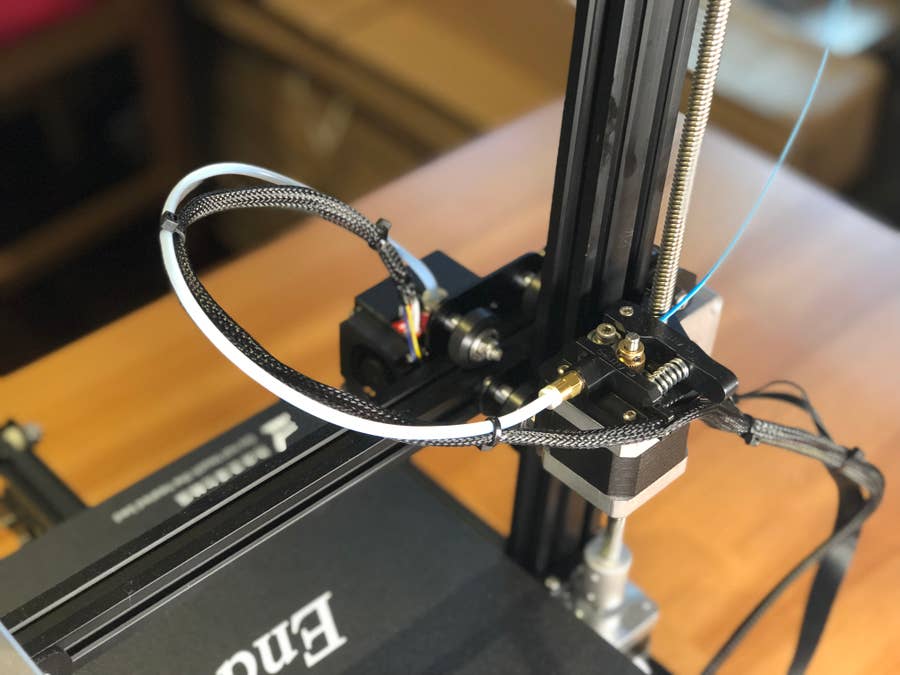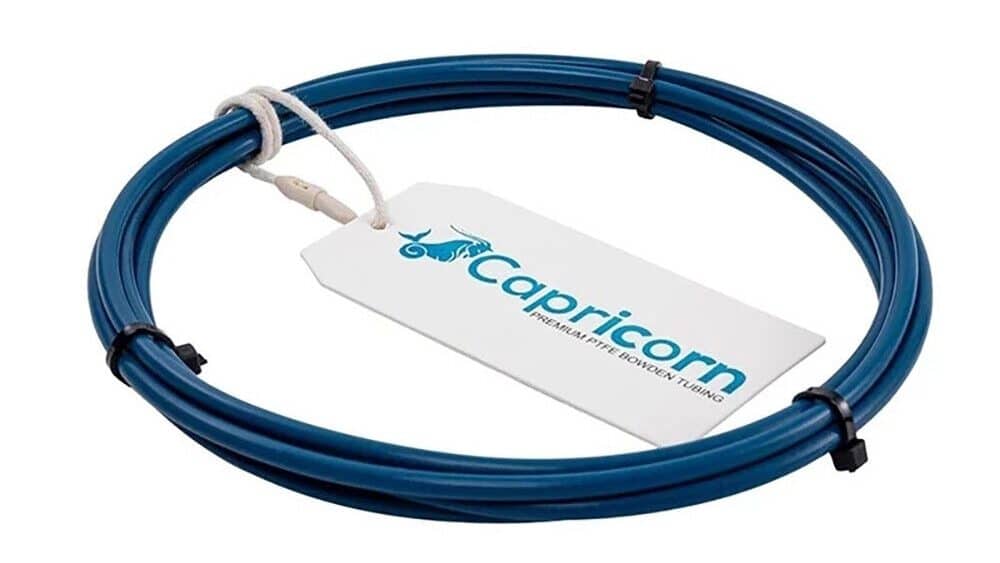

When looking around for FDM printers, you’ll most likely run across the terms Direct Drive and Bowden.
The basic principle is the same – using an extruder to push filament through a heated nozzle – the difference is where that extruder is located.
A direct extrusion system pushes the filament into the hot end by mounting the extruder on the printhead. In contrast, a Bowden system typically has the extruder mounted on the printer’s frame. To get to the printhead, the filament, therefore, passes through a PTFE tube.
Although the results of both setups are the same, the different designs have unintended consequences. We’ll address these issues and others in this comparison of direct drive vs Bowden extruder.
When we discuss direct drive and Bowden, we are explicitly referring specifically to the extruder’s mounting position and how that impacts how it feeds filament into the hot end. Although they perform the same essential task, each has a unique set of advantages and disadvantages.

The main difference between a Direct Drive extruder and a Bowden setup is basically the location of the extruder in relation to the hot end, which we will explain.
The extruder is directly connected to the hot end in a Direct Drive setup. Eventually, it develops into a sizable portion of the print head.
The printing material is, therefore, thrust directly into the nozzle by the extruder in this method of filament extrusion.
On the other hand, another concept to grasp is that the extruder and hot end have been integrated into the print head, which is now quite large. Later on in the article, the caveat will be covered. However, the distance the filament must travel is the only factor that favors and makes Direct Drive setups advantageous.
Extruders in Direct Drives setups can be found above the hot end on the print head. At the same time, it is attached to it, minimizing the distance the filament must travel from the extruder to the hot end.
Although the quality, cost, and features of each 3D printer can vary, they all share many of the same fundamental parts. A stepper motor is an essential joint component that pushes the thermoplastic filament into the extruder. In these 3D printers, the stepper motor is directly above the cold end, adding to the print head’s size.
Recommended reading: How to Get the Perfect Top and Bottom Layers in CURAThe filament travels directly from the motor to the cold end and then to the extruder.
On most printers, Direct Drives can be found as a default. This is primarily because they are generally painless to implement and reliable.
Though everything in this world has both positive and negative aspects, let’s first examine the Bowden system’s operation before moving on.

The Bowden setup offers convenience and utility in many 3D printing-related areas compared to the Direct Drive system. Before diving into why let’s explain how the Bowden system on a printer operates.
The stepper motor is removed from the print head and the hot end and attached to the printer’s frame, which is the main distinction between the Direct Drive and the Bowden setup. Again, this has several benefits, and we’ll discuss those in more detail later.
We now need a safe, grounded method of moving the filament to where it melts and is extruded. Because we have the motor that pushes the filament to the hot end at a different location. You may already know that the Bowden feed uses a long, flexible PTFE tube to hold your 3D printing materials.
The hot end, stepper motor, and PTFE tube are secured at both ends. It is just wide enough and just narrow enough to keep the filament from curling.
As a result, the filament is fed through this PTFE Bowden tube from the stepper motor to the hot end. As a result of the stepper motor being removed from the print head, the portion of the printer that moves will now only be made up of the hot end’s parts.
From this point on, it becomes apparent how the two setups might have different applications and uses based on their divergent build processes.
Popular Bowden printers: Ender 3, Voxelab Aquila, Anycubic i3 Mega S, Prusa MINI+.
We’ll examine the advantages and disadvantages of these two extruder configurations now that we know the fundamental differences between them:

The extruder is fixed to the frame in a Bowden setup, which lessens the weight load on the print head. The printer moves more precisely and is less prone to layer inconsistencies with more effective acceleration/deceleration and less jerk. Smoother motions result from a lighter print head. Higher print speeds also result in cleaner surfaces and less ringing.
Bowden printers typically operate more quietly because the stepper motors don’t have to work as hard to move the print head around.
The extruder is connected to the print head assembly in a direct drive setup. In addition to dealing with more pronounced vibration, overshooting, and wobble, which can impair print quality and accuracy at higher speeds, the printer must work harder to deliver travel movements.
Recommended reading: The Best 3D Printers for Hobbyists and ProfessionalsDespite being present, these problems can be avoided using proper slicer settings and printer tuning. However, compared to Bowden extruders, direct drive printers provide a different quality at faster speeds.
A direct drive system controls extrusion much better than Bowden systems because of the location of the extruder on the print head assembly.
As a result, better responsiveness and less effort are needed to push or pull the filament through the hot end. A direct drive extruder performs well with much less extruder stepper motor torque and less aggressive slicer settings.
On the other hand, a Bowden system offers less accurate and quick extrusion control. It needs more motor torque to move the filament. This is due to the filament’s longer path and the increased friction it creates as it passes through the PTFE tubing.
As a result, there is a lag between the movements of the hot end and the extruder. Stringing, oozing, and other extrusion-related issues are frequent.

This process is known as retracting when the extruder pulls the filament back into the hot end during travel movements. The print finish and overall print quality are improved because it prevents the filament from being forced through the hot end as the print head passes over non-print areas and lessens unsightly oozing and stringing.
Because the extruder is situated closer to the hot end in direct drive systems, retraction performance is significantly better and faster. Since it doesn’t have to exert as much effort to retract the filament, it can do so with finer precision, which lessens stringing.
With very low retraction settings, direct drive 3D printers frequently perform well. Accurate retraction is much more challenging to deliver with a Bowden extruder. It takes more effort to pull the filament back through the tube, and the filament may rub against one another as it does so, increasing resistance. As a result, retraction is slower, less responsive, and requires more intense in-slicer tuning to function correctly.
The ability of a direct drive extruder to print flexible and abrasive materials, particularly TPU, is one of its key advantages. Contrary to Bowden systems, there is less chance for issues to arise due to the more precise filament control, better retraction, and significantly shorter filament path. The materials are particularly prone to jamming and clogging as they wear, bend, and bind because of their flexibility or abrasiveness. These problems become more severe as the filament travels through the lengthy Bowden tubing, impairing the extruder’s grip and, consequently, its capacity to correctly regulate the filament flow.
Recommended reading: Why PETG Filament is the Best Choice for Your 3D Printing ProjectsExcessive oozing and stringing are common symptoms of a Bowden system struggling with materials other than PLA and ABS. The latter produces wispy strands of filament on prints that necessitate extensive post-processing.
The issue cannot be avoided entirely with a Bowden extruder, even with ideal settings and printer modifications. As a result, if you intend to work primarily with flexibles, a direct drive printer is what you need.
The printing of PLA and ABS is more than capable by a well-tuned Bowden 3D printer.
E3D Hemera Direct Drive Kit – a complete direct drive upgrade fit for various printers, including the enduringly well-liked Ender 3. You are purchasing high-quality since E3D is one of the most well-known producers of hot ends, nozzles, and extruders. It’s also worthwhile to look at the E3D Titan.

Micro Swiss Direct Drive Kit – Another top-notch direct drive upgrade kit from a well-known brand in the printer component industry. It includes a dual-drive train and the renowned all-metal hot end from Micro Swiss.

Capricorn Bowden Tubing: The simplest and most affordable way to improve a sluggish Bowden system is to upgrade to a Capricorn-branded tube, which is renowned for its extra lubrication and high-quality PTFE.
Bondtech BMG Dual Drive Extruder: Low-cost printers’ stock extruders can be hit-or-miss; some even use plastic to save money, which can affect drip and hasten wear and tear. A more dependable and durable part, like the Bondtech BMG Dual Drive Extruder, is easily upgradeable. It is portable, has a great 3:1 gear ratio, and is simple to install.
Yes, stringing incidents are significantly decreased by direct drive extruders. Because the distance between the extruder and the hot end is much shorter, the extruder needs to exert much less force to push and pull the filament, which results in less lag when extruding and retracting. Less stringing results from improved and more precise filament control.
Not always; it all depends on your preferences, willingness to fine-tune slicer settings, and the material being used. Since flexibles cannot bend, snap, or wear away in the long tubing on a Bowden extruder system, direct drive is unquestionably better for flexibles. However, Bowden is a better option if you’re using PLA or ABS and want faster print speeds with less impact on overall print quality.
A direct drive upgrade is strongly advised if you print flexibles like TPU. Stringing, one of the main problems affecting Bowden setups can almost entirely be eliminated by an adequately tuned direct drive extruder. Additionally, improved retraction control lessens additional extrusion-related issues.
Again, the definition of better is arbitrary and is based on the predominant material used. Direct drive is typically indisputably superior for flexible materials like TPU, while PLA/ABS performance is comparable for both systems. Direct drive extruders provide better filament control and retraction, but Bowden extruders typically handle higher speeds better.
What are your thoughts about bowden and direct drive extruder setups?
Let us know in the comments below or on our Facebook page to let us know your ideas, and we would appreciate seeing pictures of your works of art!